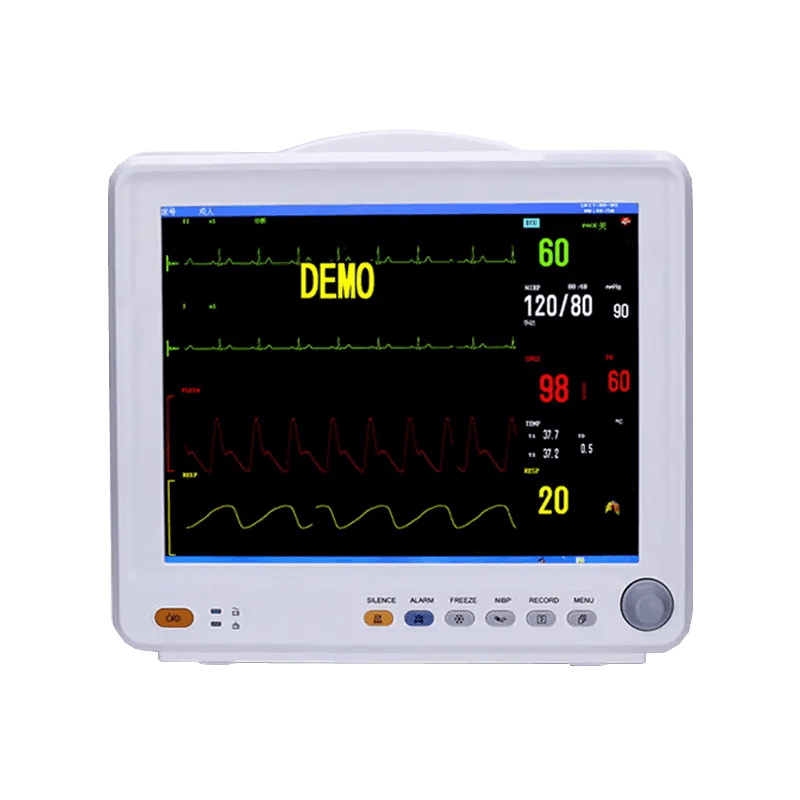Affordable Cardiac Monitors at Your Doorstep in Lahore, Karachi & Islamabad
Looking For Affordable Oxygen Concentrators? Contact: 03196592050
Health Ease's Cardiac Monitors Line
What are Cardiac Monitors?
A Cardiac Monitor is an essential medical device designed for the continuous monitoring of heart activity. These devices play a crucial role in the healthcare sector, especially in diagnosing and managing heart-related conditions. By tracking the electrical and pressure waveforms of the heart, cardiac monitors provide invaluable data that help healthcare professionals understand how well a patient’s heart is functioning. This information is critical in detecting abnormal heart rhythms, known as arrhythmias, and other cardiac conditions that could lead to more severe health issues if left unchecked.
Cardiac monitors are vital in the early detection, diagnosis, and management of heart-related conditions. Their ability to provide continuous, real-time data on a heart’s activity makes them indispensable tools in both clinical and research settings.
What is a Cardiac Monitor
Types of Cardiac Monitors
Various types of cardiac monitors cater to different needs and circumstances:
Holter Monitors: These are portable devices worn by patients for a duration, typically 24 to 48 hours. Holter monitors continuously record the heart’s electrical activity, offering insights into the heart’s behavior during a patient’s daily activities.
Event Monitors: Similar to Holter monitors, event monitors are used for longer periods. The key difference is that they record heart activity only at certain times, such as when a patient feels symptoms or manually activates the device. This type of monitoring is beneficial for detecting intermittent arrhythmias that may not show up in a standard ECG test.
Implantable Loop Recorders: These are small devices surgically placed under the skin in the chest area. Implantable loop recorders constantly monitor heart activity for extended periods, up to a few years, and are particularly useful in diagnosing elusive, infrequent heart rhythm abnormalities.
Importance of Cardiac Monitors
The significance of cardiac monitors in modern medicine cannot be overstated. They are indispensable tools for:
Early Detection: By providing continuous monitoring, cardiac monitors can help detect heart conditions long before symptoms become apparent.
Diagnosis: They enable precise diagnosis of heart rhythms and other abnormalities, guiding healthcare providers in choosing the most effective treatment plans. Cardiac Monitors on Rent/Sale in Lahore.
Management: For patients with known heart conditions, these monitors are crucial in managing their health, helping to adjust medications and interventions as needed.
Research: Cardiac monitors also contribute to cardiac research, offering insights into heart disease and its management.
How Do Cardiac Monitors Work?
Cardiac monitors, also known as heart monitors, are invaluable tools in the medical field for continuously observing the electrical activity of the heart. These devices are crucial for diagnosing and monitoring cardiac conditions such as arrhythmias, heart disease, and post-surgery recovery. The functionality of cardiac monitors hinges on a sophisticated blend of physical sensors, electrical engineering, and data analysis algorithms. This article delves into the intricate process from the physical attachment of the monitor to a patient, through to the interpretation of the heart’s electrical signals.
Attachment and Electrodes
The journey of cardiac monitoring begins with the attachment of the device to the patient. This is typically done using electrodes, which are small, conductive pads adhered to the skin. For a standard electrocardiogram (ECG or EKG), these electrodes are placed at strategic points on the patient’s chest, arms, and legs. The precise placement of these electrodes is critical for accurate signal acquisition.
The role of these electrodes is to detect the tiny electrical changes on the skin that arise from the heart muscle’s electrophysiological pattern of depolarizing and repolarizing during each heartbeat. In essence, these electrodes act as sensors that convert the ion-based electrical activity of the body into electronic signals that can be measured and recorded.
Signal Amplification and Filtering
Once the electrical signals are picked up by the electrodes, they are typically too minute to be analyzed directly. This is where signal amplification comes into play. The raw signals are amplified to a level where they can be analyzed effectively. However, this amplification process also increases the noise—unwanted electrical signals from muscle movements, electrical devices in the environment, or even poor electrode contact.
To address this, cardiac monitors employ filtering techniques to isolate the true heart signal from the noise. This involves both hardware and software components within the monitor that are designed to reject frequencies not associated with the heart’s electrical activity. Know more about Cardiac Monitors on Rent/Sale in Lahore.
Digital Conversion and Data Analysis
After amplification and filtering, the analog electrical signals representing the heart’s activity are converted into digital data. This conversion is crucial for detailed analysis and long-term storage of the information. Modern cardiac monitors use high-resolution digital conversion techniques to ensure that the digital representation of the heart’s activity is as accurate and detailed as possible.
The digital data is then analyzed using sophisticated algorithms. These algorithms are designed to identify patterns within the electrical signals that correspond to specific heart rhythms or abnormalities. They can distinguish between normal heart activity and various types of arrhythmias or other conditions. This analysis can be done in real-time, providing immediate feedback to medical personnel, or it can be stored for later review by a specialist.


